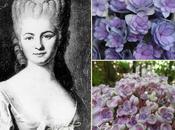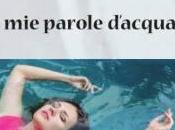Molti sono i critici a supporre oggi che vi sia una stretta analogia, anzi un parallelo, tra Charlotte Brontë e Jane Eyre, la protagonista dell'omonimo romanzo da lei scritto nel 1846, ovvero, che ad ispirarle questo romanzo, le vicissitudini della giovane che lo animano e le sue caratteristiche personologiche siano stati proprio il suo stesso temperamento, le concezioni che nutriva e che al tempo, forse, quale donna, non le era culturalmente concesso di esprimere apertamente e la sua esistenza fino ad allora vissuta;
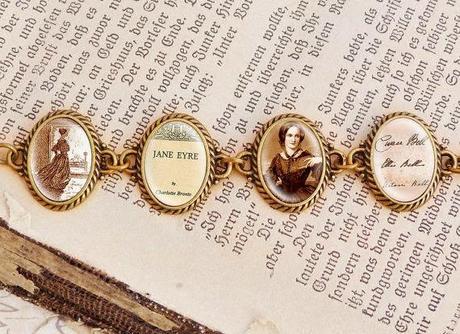
perciò quello di Jane Eyre rappresenterebbe una sorta di ritratto in parte reale in parte ideale di Charlotte Brontë stessa.
Attingendo al ritratto che di lei traccia la scrittrice ed amica Elizabeth Gaskell, vicina all'autrice anche nei momenti di vita quotidiana, si trovano frequenti analogie già di
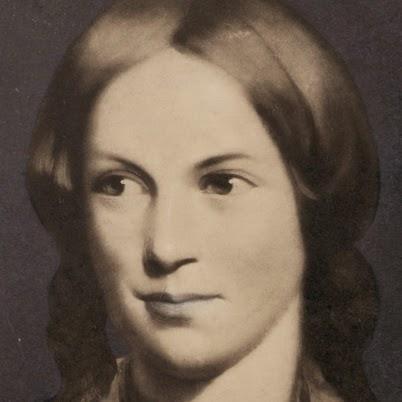 natura biografica: Charlotte Brontë nacque a Thornton nello Yorkshire nel 1816, terza dei sei figli di Maria ( nata Branwell ) e di Patrick Brontë, soprannominato Brunty o Prunty, pastore anglicano di origini irlandesi; dopo la morte prematura delle madre nel 1821 Charlotte fu inviata con tre delle sue sorelle, Emily, Maria ed Elizabeth alla Clergy Daughters' Scholl a Cohan Bridge, in Lancashire, luogo tetro, angusto e malsano che le ispirerà in futuro la Lowood School in Jane Eyre, insalubre al punto da cagionarle irrimediabilmente la salute e da procurare il decesso per tubercolosi alle due sorelle maggiori Maria ed Elizabeth; venne quindi con Emily ricondotta a casa dal padre presso la canonica di Haworth in cui egli prestava la propria opera pastorale, dove ella, quale sorella maggiore, seguirà i fratelli rimasti come un amica materna ed un angelo custode.
natura biografica: Charlotte Brontë nacque a Thornton nello Yorkshire nel 1816, terza dei sei figli di Maria ( nata Branwell ) e di Patrick Brontë, soprannominato Brunty o Prunty, pastore anglicano di origini irlandesi; dopo la morte prematura delle madre nel 1821 Charlotte fu inviata con tre delle sue sorelle, Emily, Maria ed Elizabeth alla Clergy Daughters' Scholl a Cohan Bridge, in Lancashire, luogo tetro, angusto e malsano che le ispirerà in futuro la Lowood School in Jane Eyre, insalubre al punto da cagionarle irrimediabilmente la salute e da procurare il decesso per tubercolosi alle due sorelle maggiori Maria ed Elizabeth; venne quindi con Emily ricondotta a casa dal padre presso la canonica di Haworth in cui egli prestava la propria opera pastorale, dove ella, quale sorella maggiore, seguirà i fratelli rimasti come un amica materna ed un angelo custode.Ultimata la propria formazione culturale presso la Roe Head di Mirfield nel 1832, dove tornerà in qualità di insegnante dal 1835 al 1838, dopo aver prestato servizio come istitutrice presso alcune famiglie del luogo, si recherà con la sorella Emily a Bruxelles nel 1842 dove venne assunta nel collegio gestito da Costantin Heger e dalla moglie Claire Zoé quale insegnante di lingua inglese - Emily insegnava musica - ed entrambe alloggeranno presso gli Heger che, fornendo loro vitto ed un tetto, così ripagavano il loro lavoro al collegio.
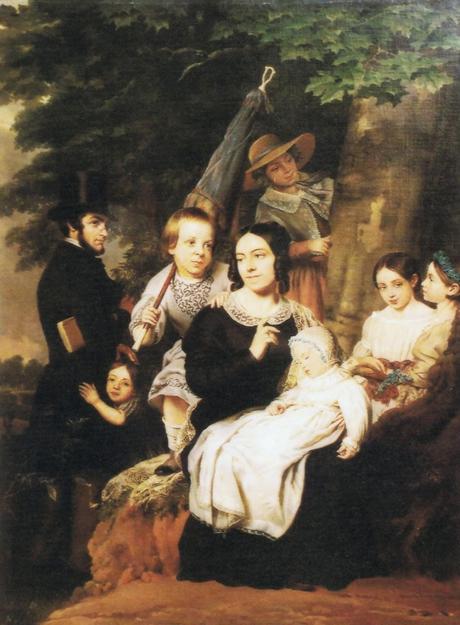
The Heger family by Ange Francois, 1846
Fu quello un periodo felice per Charlotte, ma di troppo breve durata, poichè la morte della sorella della madre ricondusse molto presto lei ed Emily a casa; Charlotte tornò sola a Bruxelles, ma il crescente trasporto per Mr.Heger ( l'amore per un uomo sposato ci riporta a quello di Jane Eyre per Mr.Rochester ) e la nostalgia di casa la riporteranno ad Haworth dove, nel 1846, comincerà con il pubblicare una raccolta di poesie insieme con le sorelle Emily ed Anne sotto i rispettivi pseudonimi di Currer, Ellis ed Acton Bell e sempre con lo pseudonimo di Currer Bell Charlotte pubblicherà il suo romanzo, il primo ed il più grande, che immediatamente divenne celebre:
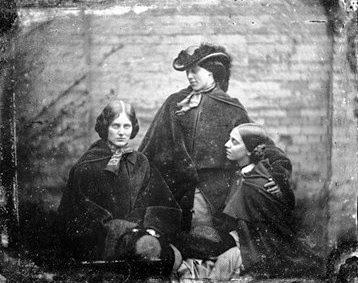
Le sorelle Brontë ( da sinistra Charlotte, Anna ed Emily ) in una fotografia del 1845
Già dalla prima apparizione in pubblico del romanzo Jane Eyre nel 1847, la Gaskell, come molti dei suoi lettori, fu posseduta dall'energia del romanzo e affascinata dal mistero dell'identità del suo autore. Attraverso una rete di amici e conoscenti, aveva stabilito che il misterioso ' Currier Bell ' fosse una donna: "Currer Bell ( Aha ! che segreto volete mai raccontarmi ?) E' una lei - ecco cosa vi dico". ! - 1
Tra il 1848 ed il 1849 Charlotte perderà l'unico fratello, Branwell, dedito all'oppio ed accanito bevitore, strappato alla vita da una bronchite acuta, e le due sorelle decedute per tubercolosi e da allora si dedicherà alla cura del padre rimasto ormai il solo con cui condividere la casa e le proprie giornate, ferma restando l'ormai irrinunciabile arte dello scrivere.
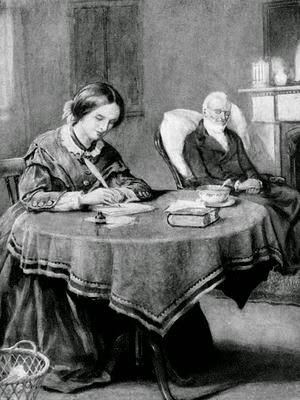
Nel 1854 sposerà Arthur Nicholls, il curato che affiancava il padre in canonica, e, nel tentativo di dargli un figlio, si spegnerà alla giovane età di soli 38 anni nel 1855.
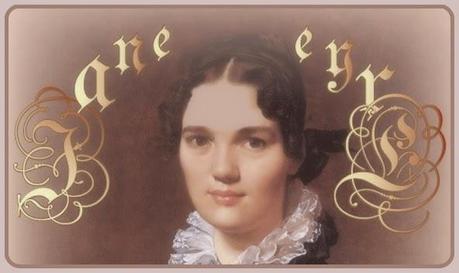 JANE EYRE - A tutta prima il romanzo scritto da Charlotte Brontë nel 1846 altro non sembra che una storia d'amore, quella tra una giovane fanciulla orfana vittima serena di una vita amareggiata dalla povertà e dai maltrattamenti, ed il ricco e burbero Mr.Rochester, eroe romantico tormentato dai moti del suo animo, la storia di un amore sicuramente difficile da portare a compimento, ma in realtà per tramite di questa vicenda l'autrice dà voce ad una serie di tematiche a lei molto care.
JANE EYRE - A tutta prima il romanzo scritto da Charlotte Brontë nel 1846 altro non sembra che una storia d'amore, quella tra una giovane fanciulla orfana vittima serena di una vita amareggiata dalla povertà e dai maltrattamenti, ed il ricco e burbero Mr.Rochester, eroe romantico tormentato dai moti del suo animo, la storia di un amore sicuramente difficile da portare a compimento, ma in realtà per tramite di questa vicenda l'autrice dà voce ad una serie di tematiche a lei molto care.Innanzitutto quella che nel romanzo viene rappresentata è una società patriarcale, tipica del periodo vittoriano, in cui a fatica Jane cerca di affermare sé stessa circondata da personaggi maschili che tentano di mantenerla in una posizione subordinata, da Mr.Brocklehurst preside della Logwood School, sadico e violento con i propri studenti, a Mr.Rochester per il quale lavora come istitutrice della fanciulla che ha avuto in affidamento e di cui è chiamato ad occuparsi a St.John Eyre Rivers, l'ecclesiastico che si rivelerà essere un cugino di Jane fortemente guidato dal proprio credo; solamente alla fine del romanzo ella si concede in sposa a Mr.Rochester, colui il quale sostiene apertamente che, nonostante la diversità di ruoli e di estrazione sociale, Jane e lui sono uguali ed il loro si qualifica così come un matrimonio tra due persone profondamente identiche tra loro: il mondo interiore governerebbe quindi i principi al di là delle apparenze, ogni essere umano, secondo Charlotte, deve essere apprezzato in quanto individuo prima ancora che come essere sociale.
Questo è da considerarsi, al tempo in cui fu concepito, un punto di vista sicuramente anti-vittoriano, espressione di una filosofia antesignana di quella che verrà più tardi definita femminista tenuto conto del fatto che le donne all'epoca non potevano pensare ad altro che a governare la casa, a cucinare puddings per la famiglia, a ricamare borse, lavorare la maglia e suonare il pianoforte; secondo la concezione di Charlotte ogni donna, fermo restando il fatto che deve apparire sempre calma e docile, quasi fossero quelle della fermezza e della mitezza virtù che il gentil sesso deve orgogliosamente custodire, non è diversa dagli uomini in ciò che sente, in ciò che soffre, in ciò che desidera e soprattutto in ciò che ama.

Frederick Walker ( 1840 - 1875 ) Rochester and Jane Eyre
Una vita senza amore è per Jane ( e per Charlotte, quindi ) una vita non degna di essere vissuta; Jane è moralmente retta tanto che la sua integrità morale le impone di lasciare Mr.Rochester, già sul punto di maritarlo nonostante la disapprovazione generale, perchè, una volta scopertolo già sposato, avrebbe dovuto continuare a vivere al suo fianco quale sua amante, è intelligente, amorevole ed intellettuale, tutte doti pregevoli che fanno di lei la donna ideale per Rochester il quale la ama vedendo in lei innanzitutto il suo valore come persona, ed è questo, a mio avviso, il grande e profondo messaggio che con Jane Eyre Charlotte Brontë ci ha voluto consegnare, un messaggio che si legge tra le righe di questo suo grande romanzo, un messaggio che ci proviene da un'epoca ancora governata dalle apparenze, dallo 'status sociale' e dalle gerarchie e perciò non pronta per comprenderne appieno il significato ed il valore.
Ancora una volta una donna dalla sensibilità e dall'intuito eccezionali precorre i tempi qualificandosi tutt'oggi messaggera di concezioni di estrema attualità ed esibendo un ideale tutt'ora da perseguire.
Poi, nel mese di agosto del 1850, su invito di Sir James e Lady Kay-Suttelworth, la Gaskell si recò a Briery Close, vicino Windermere. Lì conobbe Charlotte Bronte, un incontro che condusse ad una amicizia che fu molto importante, nonostante la sua brevità, per il calore e l'intimità che la connotarono, e che determinò la natura tutta di 'The Life' quando venne scritta. La Gaskell fu colpita dalla figura infantile, ' una persona così tanto minuta ed oscura ', vestita di nero, e con le mani con dita affusolate come quelle di un piccolo uccello. Tale senso di sofferenza e di deprivazione che allora avvertì nel guardarla farà da sottofondo a tutta la biografia che ne scriverà. 2
... sì, mi piacerebbe un giorno leggere anche questo testo con voi ...
Vi ringrazio di cuore per avermi seguita anche in questo mio piccolo viaggio tra le pagine di questo splendido romanzo senza tempo e vi saluto con tutto il cuore augurandovi ogni bene.
A presto ♥
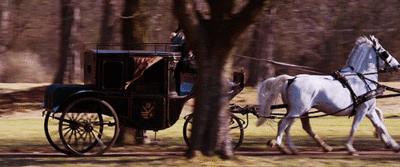

Bibliografia:
Charlotte Brontë, Jane Eyre, Newton Compton, 2010
Laura Joh Rowland, The Secret Adventures of Charlotte Bronte, Penguin Group (USA), 2008
Elizabeth Gaskell, Life of Charlotte Brontë, OUP Oxford Publisher, 2009
OUP Oxford, 2009
Juliet Barker, The Brontes: Wild Genius on the Moors: The Story of a Literary Family, Pegasus, 2013
Citazioni:
1 - Elizabeth Gaskell, Life of Charlotte Brontë, OUP Oxford Publisher, 2009
OUP Oxford, 2009, Introduction, p.ix
2 - ibidem

Several critics do agree to assume today that there's a close analogy, even a parallel between Charlotte Brontë and Jane Eyre, the protagonist of the novel she wrote in 1846, that is, that to inspire this novel, the vicissitudes of the young girl who animates it and the characteristics of her personality it was just her own temperament, the ideas she felt and that at the time, perhaps, as a woman, she wasn't culturally allowed to openly express and her own existence until then lived;
- picture 1
therefore Jane Eyre would represent a sort of portrait part in real and part in ideal of Charlotte Brontë herself.
Drawing on the portrait of her that the writer and friend Elizabeth Gaskell traces, close to the author even in moments of everyday life, there are frequent analogies already by
- picture 2 o the left - biographical nature: Charlotte Brontë was born at Thornton in Yorkshire in 1816, the third of six children born to Maria (née Branwell ) and Patrick Brontë surnamed Brunty or Prunty, Anglican clergyman of Irish descent; after the untimely death of her mother in 1821, Charlotte was sent with three sisters of hers, Emily, Mary and Elizabeth to the Clergy Daughters' Scholl at Cohan Bridge, Lancashire, a gloomy place, cramped and unhealthy thet in the future will inspire the Lowood School in Jane Eyre, unhealthy enough to cause irreparable damage to her health and to procure the death from tuberculosis at the two older sisters Mary and Elizabeth; together with Emily she was then brought back home by her father at the Haworth Parsonage where he lent his pastoral work and where she, as older sister, followed the remaining siblings as a motherly friend and a guardian angel.
After completing her cultural education at the Roe Head Mirfield in 1832, where she returned as a teacher from 1835 to 1838, after working as a governess by a few local families, she will go with her sister Emily to Brussels in 1842, where she was employed at the college run by Constantin Heger and his wife Claire Zoé as a teacher of English language - Emily taught music - and both will stay by the Hegers that, by providing them with food and a roof, so repaid their work at their college.
- picture 3 - The Heger family by Ange Francois, 1846
That was a happy time for Charlotte, but of too short duration, since the death of her mother's sister brought back she and Emily at home very soon; Charlotte returned alone to Brussels, but the growing transport for Mr.Heger ( the love for a married man brings us back to that of Jane Eyre for Mr.Rochester ) and the homesickness will report her to Haworth, where, in 1846, will begin with publish a collection of poems along with her sisters Emily and Anne under the respective pseudonyms of Currer, Ellis and Acton Bell, and always under the pseudonym Currer Bell Charlotte will publish her novel, the first and biggest one, which immediately became famous:
- picture 4 - The Brontë sisters (from left Charlotte, Anne and Emily) in a photo from 1845
From the first appearanace of Jane eyre in 1847, Gaskell, like so many of its readers, had been possessed by the energy of the novel and fascinated by the mistery of its author's identity. Early on, through a network of friends and acquaintances, she had estabilished that the mysterious 'Currier Bell' was a woman : " Currer Bell (aha ! what will you give me for a secret? ) She's a she - that I will tell you ". ! - 1
Between the years 1848 and 1849 Charlotte lost the only brother Branwell, addicted to opium and avid drinker, ripped from life by acute bronchitis, and the two sisters died of tuberculosis, and then she'll devote to the care of her father who was now the only one with whom to share her house and her days, being understood the indispensable art of writing.
- picture 5
In 1854 she'll marry Arthur Nicholls, the priest who worked side by side with her father in the rectory, and in an the attempt to give him a son, will shut down at the young age of only 38 years in 1855.
- picture 6 on the left - JANE EYRE - At first the novel written by Charlotte Bronte in 1846 doesn't seem more than a love story, that of a young orphaned girl serene victim of a life embittered by poverty and ill-treatment, and the rich and surely Mr.Rochester, tormented by the motions of his soul, the story of a love definitely difficult to bring to fruition, but in reality by means of this the authoress gives voice to a number of issues which were very dear to her.
First of all, what is represented in this novel is a patriarchal society, typical of the Victorian period, in which Jane fatigues tries to assert herself surrounded by male characters who try to keep her in a subordinate position, such as Mr.Brocklehurst, dean of the Lowood School, sadistic and violent with his pupils, Mr.Rochester for which she works as a governess of the young girl he had in custody and of which he's called upon to take care of and St.John Eyre Rivers, the clergyman that will prove to be a Jane's cousin strongly driven by his belief; only at the end of the novel she gave herself in marriage to Mr.Rochester, the one who openly says that, despite the diversity of roles and social status, Jane and him are equal, and their marriage qualifies as a marriage between two people deeply identical to each other: the inner world would then govern the principles beyond the appearances, every human being, according to Charlotte, has to be appreciated as an individual even before than as a social being.
This has to be considered, at the time in which it was conceived, a point of view certainly anti- Victorian, expression of a philosophy forerunner of what will later be defined a feminist view given that women at that time couldn't think of nothing but to govern the house, to cook puddings for their family, embroidering bags, to knittle and play the piano; according to the conception of Charlotte every woman, notwithstanding the fact that should always appear calm and docile, almost as if those of firmness and gentleness are virtues that the fairer sex has proudly to cherish, isn't different from men in what she feels, in what she suffers, in what she want and especially in what she loves.
- picture 7 - Frederick Walker (1840 - 1875) Rochester and Jane Eyre
A life without love is for Jane ( and Charlotte, then ) a life not worth living; Jane is morally upright so that her moral integrity order her to leave Mr.Rochester, already on the verge of marry him despite the general disapproval, because, once discover him already married, she should continue to live at his side as his mistress, is intelligent, loving and intellectual, all valuable qualities that make her the ideal woman for Rochester who loves her seeing in her first of all her value as a person, and this is, in my opinion, the great and profound message that with Jane Eyre Charlotte Brontë wanted to deliver us, a message that we read between the lines of her great novel, a message that comes to us from an era still governed by appearances, by the ' social status ' and hierarchies and therefore not ready to fully understand the meaning and value of it.
Once again a woman with exceptional sensitivity and intuition far ahead of her time qualifies herself as a messenger of conceptions of extreme topically and exhibites an ideal still to be pursued.
And I would like to conclude with the words with which Elizabeth Gaskell describes to her readers this delicate girl after meeting her for the first time, thus establishing a lasting and sincere friendship:
Then in August 1850, at the invitation of Sir James and Lady Kay-Suttelworth, Gaaskell went to Briery close, nera Windermere. there she first met Charlotte Bronte, an encounter that led to a friendship remarkable, despite its brevity, for warmth and intimacy, and one that determined the nature of The Life when it came to be written. Gaskel was struck by the childlike figure, 'a little wee dark person', dressed in black, and with hands like birds' claws. Gaskell sense of deprived and suffering soffuses The Life2
... yes I'd like one day to read this text too with you ...
I sincerely thank you for having followed me even in this little journey of mine through the pages of this wonderful novel with no time and greet you with all my heart wishing you all the best.
See you soon ♥
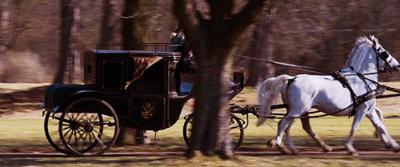

Bibliography:
Charlotte Brontë, Jane Eyre, Newton Compton, 2010
Laura Joh Rowland, The Secret Adventures of Charlotte Bronte, Penguin Group (USA), 2008
Elizabeth Gaskell, Life of Charlotte Brontë, OUP Oxford Publisher, 2009
OUP Oxford, 2009
Juliet Barker, The Brontes: Wild Genius on the Moors: The Story of a Literary Family, Pegasus, 2013
Quotations:
1 - Elizabeth Gaskell, Life of Charlotte Brontë, OUP Oxford Publisher, 2009
OUP Oxford, 2009, Introduction, p.ix
2 - ibidem
